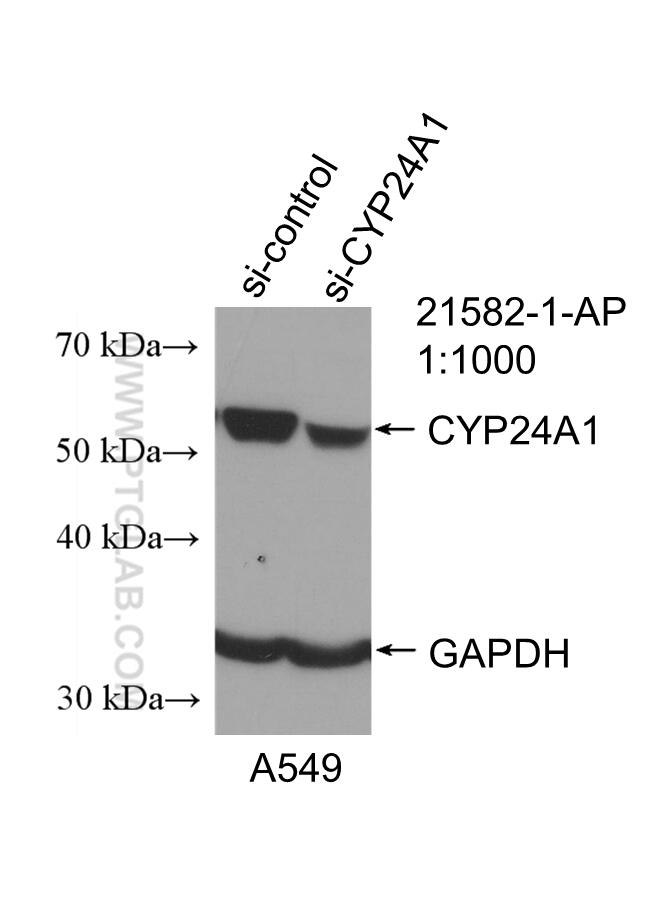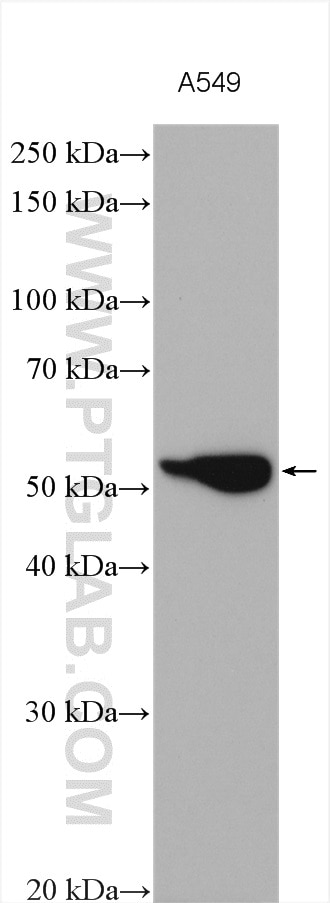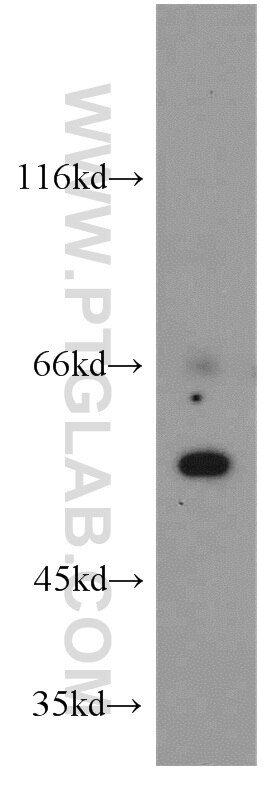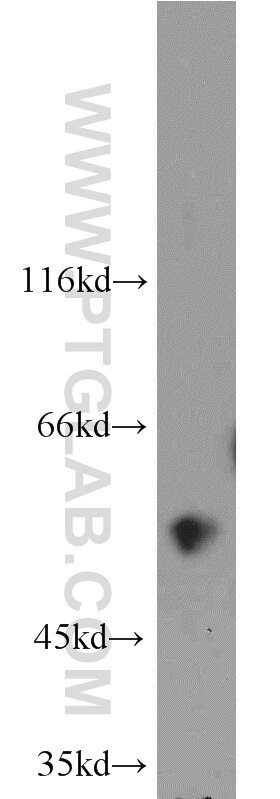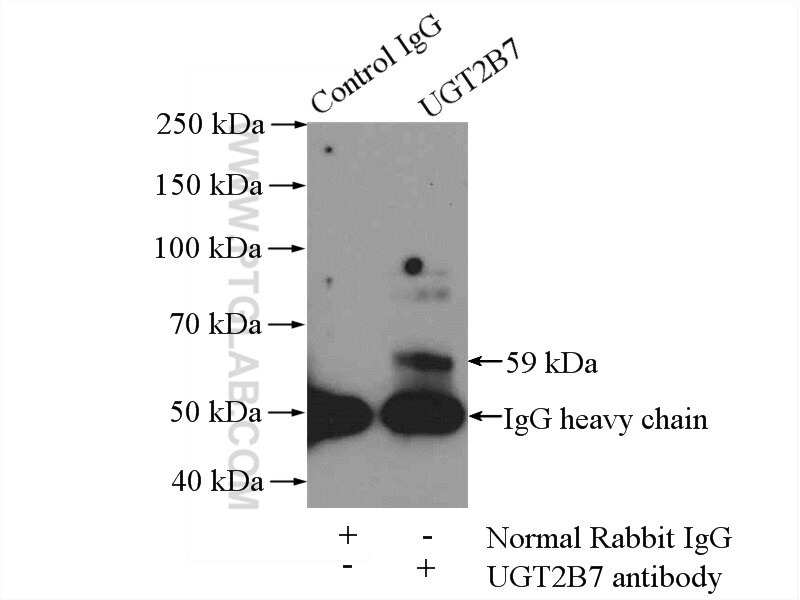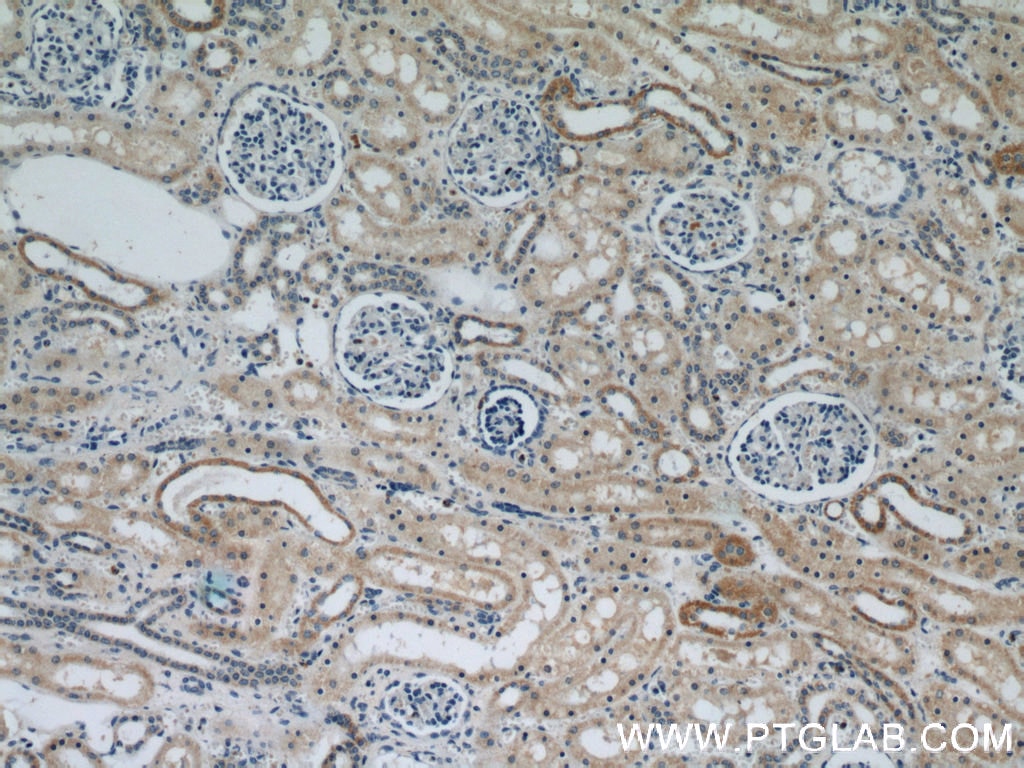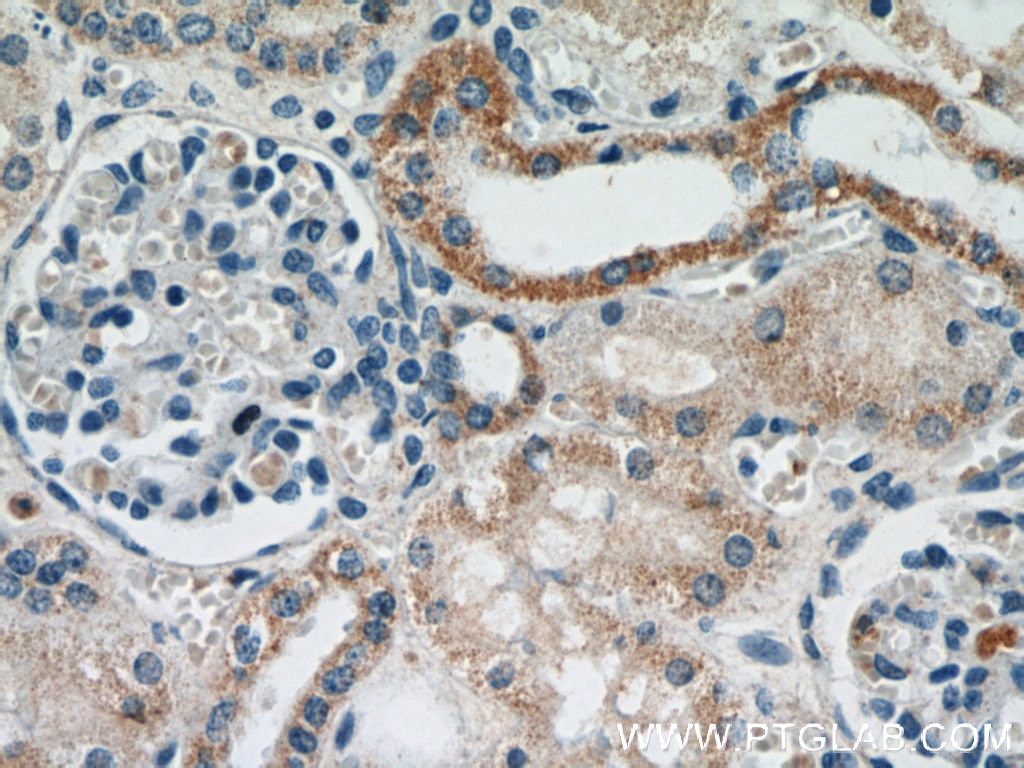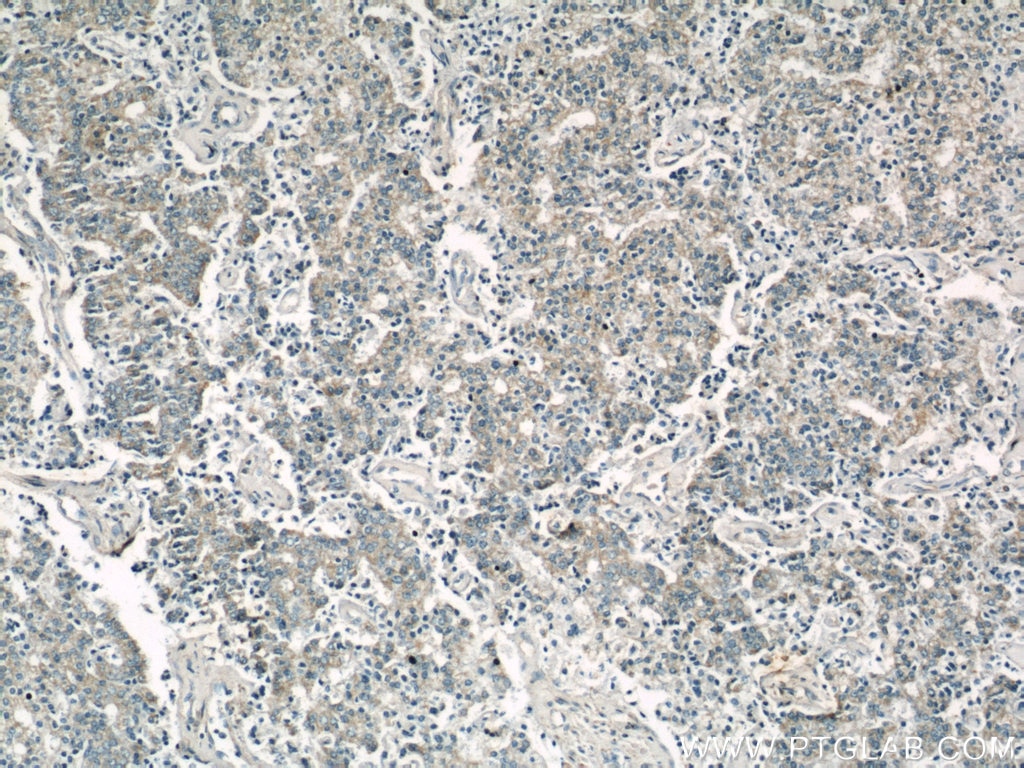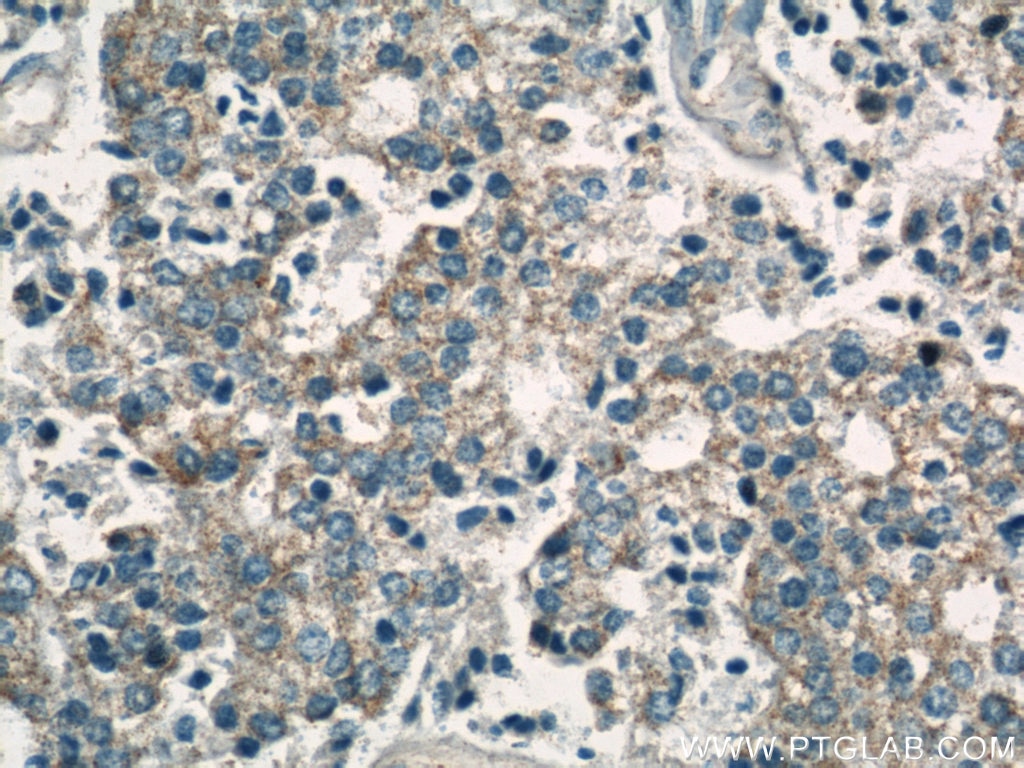Tested Applications
| Positive WB detected in | A549 cells, HeLa cells |
| Positive IP detected in | HeLa cells |
| Positive IHC detected in | human kidney tissue, human prostate cancer tissue Note: suggested antigen retrieval with TE buffer pH 9.0; (*) Alternatively, antigen retrieval may be performed with citrate buffer pH 6.0 |
Recommended dilution
| Application | Dilution |
|---|---|
| Western Blot (WB) | WB : 1:500-1:1000 |
| Immunoprecipitation (IP) | IP : 0.5-4.0 ug for 1.0-3.0 mg of total protein lysate |
| Immunohistochemistry (IHC) | IHC : 1:20-1:200 |
| It is recommended that this reagent should be titrated in each testing system to obtain optimal results. | |
| Sample-dependent, Check data in validation data gallery. | |
Published Applications
| KD/KO | See 2 publications below |
| WB | See 20 publications below |
| IHC | See 8 publications below |
| IF | See 1 publications below |
Product Information
21582-1-AP targets CYP24A1 in WB, IHC, IF, IP, ELISA applications and shows reactivity with human samples.
| Tested Reactivity | human |
| Cited Reactivity | human, mouse, rat |
| Host / Isotype | Rabbit / IgG |
| Class | Polyclonal |
| Type | Antibody |
| Immunogen |
CatNo: Ag16134 Product name: Recombinant human CYP24A1 protein Source: e coli.-derived, PGEX-4T Tag: GST Domain: 1-350 aa of BC109083 Sequence: MSSPISKSRSLAAFLQQLRSPRQPPRLVTSTAYTSPQPREVPVCPLTAGGETQNAAALPGPTSWPLLGSLLQILWKGGLKKQHDTLVEYHKKYGKIFRMKLGSFESVHLGSPCLLEALYRTESAYPQRLEIKPWKAYRDYRKEGYGLLILEGEDWQRVRSAFQKKLMKPGEVMKLDNKINEVLADFMGRIDELCDERGHVEDLYSELNKWSFESICLVLYEKRFGLLQKNAGDEAVNFIMAIKTMMSTFGRMMVTPVELHKSLNTKVWQDHTLAWDTIFKSVKACIDNRLEKYSQQPSADFLCDIYHQNRLSKKELYAAVTELQLAAVETTANSLMWILYNLSRNPQVQQ Predict reactive species |
| Full Name | cytochrome P450, family 24, subfamily A, polypeptide 1 |
| Calculated Molecular Weight | 514 aa, 59 kDa |
| Observed Molecular Weight | 54-59 kDa |
| GenBank Accession Number | BC109083 |
| Gene Symbol | CYP24A1 |
| Gene ID (NCBI) | 1591 |
| RRID | AB_10792804 |
| Conjugate | Unconjugated |
| Form | Liquid |
| Purification Method | Antigen affinity purification |
| UNIPROT ID | Q07973 |
| Storage Buffer | PBS with 0.02% sodium azide and 50% glycerol, pH 7.3. |
| Storage Conditions | Store at -20°C. Stable for one year after shipment. Aliquoting is unnecessary for -20oC storage. 20ul sizes contain 0.1% BSA. |
Background Information
CYP24A1(1,25-dihydroxyvitamin D(3) 24-hydroxylase, mitochondrial) catalyzes the NADPH-dependent 24-hydroxylation of calcidiol (25-hydroxyvitamin D3) and 1-alpha,25-dihydroxyvitamin D3. Cholecalciferol is metabolised by the 25-hydroxylases (CYP2R1 and CYP27A1) in the liver, before 25-hydroxycholecalciferol (25(OH)D3) relocates to the circulation (PMID:20362668). The gene CYP24A1 has three isoforms, for the transit peptide "mitochondrial domain" removed, the MW of CYP24A1 will be 55-59 kDa, 47-51 kDa and 43 kDa. This antibody is specific to CYP24A1.
Protocols
| Product Specific Protocols | |
|---|---|
| IHC protocol for CYP24A1 antibody 21582-1-AP | Download protocol |
| IP protocol for CYP24A1 antibody 21582-1-AP | Download protocol |
| WB protocol for CYP24A1 antibody 21582-1-AP | Download protocol |
| Standard Protocols | |
|---|---|
| Click here to view our Standard Protocols |
Publications
| Species | Application | Title |
|---|---|---|
Cancer Lett TAZ regulates cell proliferation and sensitivity to vitamin D3 in intrahepatic cholangiocarcinoma.
| ||
Acta Physiol (Oxf) Intestinal epithelial ablation of Pit-2/Slc20a2 in mice leads to sustained elevation of vitamin D3 upon dietary restriction of phosphate. | ||
J Bone Miner Res Exercise May Ameliorate the Detrimental Side Effects of High Vitamin D Supplementation on Muscle Function in Mice. | ||
Cancer Commun (Lond) Squalene epoxidase promotes colorectal cancer cell proliferation through accumulating calcitriol and activating CYP24A1-mediated MAPK signaling. | ||
J Steroid Biochem Mol Biol Eldecalcitol (ED-71), an Analog of 1α, 25-dihydroxy Vitamin D3 as a Potential Anti-cancer Agent for Oral Squamous Cell Carcinomas. | ||
J Physiol 1,25(OH)2 vitamin D3 stimulates active phosphate transport but not paracellular phosphate absorption in mouse intestine. |
Reviews
The reviews below have been submitted by verified Proteintech customers who received an incentive for providing their feedback.
FH Kenzo (Verified Customer) (08-30-2023) | This antibody appeared to work pretty well for immunofluorescence in mouse tissues.
|

